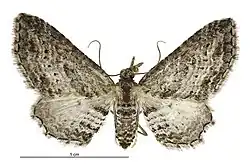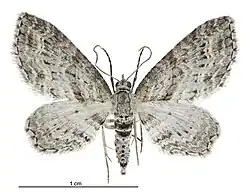Pasiphila humilis
| Pasiphila humilis | |
|---|---|

| |
| Female | |

| |
| Male | |
| Scientific classification | |
| Kingdom: | Animalia |
| Phylum: | Arthropoda |
| Class: | Insecta |
| Order: | Lepidoptera |
| Family: | Geometridae |
| Genus: | Pasiphila |
| Species: | P. humilis
|
| Binomial name | |
| Pasiphila humilis | |
| Synonyms[2] | |
| |
Pasiphila humilis is a moth of the family Geometridae.[1] This species was first described by Alfred Philpott in 1917. It is endemic to New Zealand and is most commonly observed in the South Island. The larvae feed on the flowers of species in the genus Dracophyllum. Adults are on the wing regularly from October until January.
Taxonomy
This species was first described by Alfred Philpott in 1917 using specimens collected by Merlin Owen Pasco in Queenstown.[3] In 1928 George Hudson illustrated and discussed this species under that name in his book The butterflies and moths of New Zealand.[4] In 1934 Edward Meyrick, thinking he was describing a new species, named this moth Chloroclystis melanocentra.[5] In 1971 John S. Dugdale placed this species in the genus Pasiphila.[6] In 1988 Dugdale synonymised Pasiphila melaocentra with P. humilis.[2] The male holotype, collected by Pasco and held in his collection at the Southland Museum, has been lost.[2] The female allotype, designated by Philpott, is held at the New Zealand Arthropod Collection.[2]
Description

Philpott described the adults of this species as follows:
♂♀. 22-25 mm. Head, palpi, thorax, and abdomen grey sprinkled with black. Palpi in ♀ 3+1⁄2, in ♂ slightly less. Antennae in ♂ evenly ciliated, 3⁄4. Forewings rather narrow, costa hardly arched, termen bowed, strongly oblique ; fuscous-grey, irrorated with black, sometimes with faint pink suffusion ; numerous waved white lines, more prominent on apical half of wing ; margin of the slightly darker basal portion of wing sharply and triangularly indented opposite discal spot ; a black line along termen : cilia whitish-grey with fuscous median line. Hindwings, termen unevenly rounded, in ♂ deeply sinuate above middle ; greyish-white with numerous incomplete waved bluish lines : cilia grey, obscurely barred with fuscous.[3]
Distribution
This species is endemic to New Zealand.[1] This species is most frequently observed in the South Island.[7]
Habitat and hosts
The larvae feed on the flowers of Dracophyllum species.[8]
Behaviour
The adults of this species have been observed as being commonly on the wing from October to January.[7]
References
- ^ a b c Research, Landcare. "NZOR Name Details - Pasiphila humilis (Philpott, 1917)". www.nzor.org.nz. Archived from the original on 2022-05-14. Retrieved 2025-08-07.
- ^ a b c d Dugdale , J. S. (23 September 1988). "Lepidoptera - annotated catalogue, and keys to family-group taxa". Fauna of New Zealand. 14. Department of Scientific and Industrial Research: 188. doi:10.7931/J2/FNZ.14. ISSN 0111-5383. Wikidata Q45083134.
- ^ a b Alfred Philpott (December 1917). "Art. XIII. - Descriptions of new species of Lepidoptera". Transactions and Proceedings of the New Zealand Institute. 49: 240. ISSN 1176-6158. Wikidata Q108312592.BHL page 3313371
 This article incorporates text from this source, which is in the public domain.
This article incorporates text from this source, which is in the public domain.
- ^ Hudson, G. V. (1928), The butterflies and moths of New Zealand, Illustrator: George Hudson, Wellington: Ferguson and Osborn Limited, p. 97, LCCN 88133764, OCLC 25449322, Wikidata Q58593286BHL page 61899708
 This article incorporates text from this source, which is in the public domain.
This article incorporates text from this source, which is in the public domain.
- ^ Edward Meyrick (1934). "Notes on New Zealand Lepidoptera". Transactions and Proceedings of the Royal Society of New Zealand. 64: 151. ISSN 1176-6166. Wikidata Q135656605.
- ^ Dugdale, J. S. (10 November 1971). "Entomology of the Aucklands and other islands south of New Zealand: Lepidoptera, excluding non-crambine Pyralidae". Pacific Insects Monographs. 27: 106. ISSN 0078-7515. Wikidata Q64006453.
- ^ a b "Pasiphila humilis (Philpott, 1917)". www.gbif.org. Retrieved 2025-08-07.
- ^ Brian H. Patrick; Brian M. Lyford; John B. Ward; Barbara I.P. Barratt (December 1992). "Lepidoptera and other insects of the Rastus Burn Basin, The Remarkables, Otago". Journal of the Royal Society of New Zealand. 22 (4): 276. doi:10.1080/03036758.1992.10420820. ISSN 0303-6758. Wikidata Q60326057.